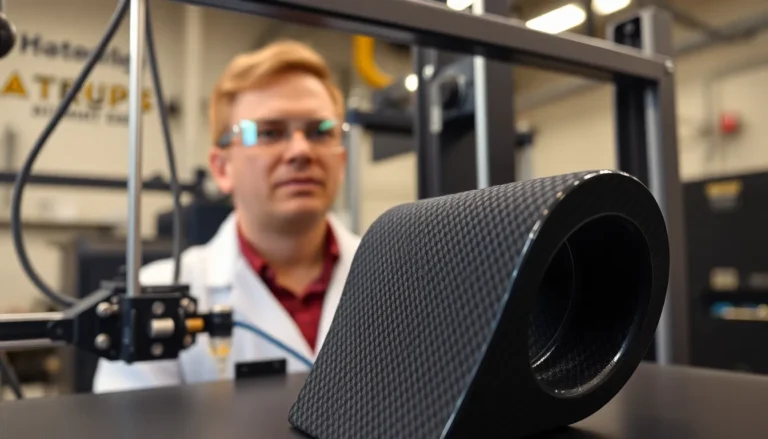Table of Contents
ToggleImagine a world where energy flows as freely as your favorite Netflix series on a lazy Sunday. The renewable energy grid is making that dream a reality, transforming how we power our homes and businesses. With the sun shining and the wind blowing, clean energy sources are stepping into the spotlight, ready to take center stage in the battle against climate change.
Overview of Renewable Energy Grid
A renewable energy grid aims to provide efficient, sustainable energy distribution across various sectors. This grid supports the transition to cleaner energy sources in homes and businesses.
Definition and Importance
A renewable energy grid refers to the infrastructure that integrates various clean energy sources, including solar, wind, and hydro, into the energy supply network. This grid enhances energy independence and reduces reliance on fossil fuels. By embracing renewable energy, communities diminish greenhouse gas emissions, making significant progress toward combatting climate change. With rising energy demands, access to a renewable energy grid becomes crucial for economic stability and environmental sustainability.
Key Components
Key components of a renewable energy grid include generation sources, storage systems, and smart technology. Generation sources harness natural resources, such as sunlight and wind, converting them into electricity. Energy storage systems, like batteries, maintain energy supply during low production periods. Smart technology monitors and manages energy flow efficiently, optimizing distribution and reducing waste. Each component plays a vital role in ensuring reliability, accessibility, and resilience within the renewable energy framework.
Types of Renewable Energy Sources

Renewable energy sources are vital for a sustainable energy grid. Understanding these sources enhances the transition towards a greener future.
Solar Energy
Solar energy captures sunlight using photovoltaic cells or solar thermal systems. This energy can power homes, businesses, and large-scale solar farms. According to the Solar Energy Industries Association, solar installations reached 18.2 gigawatts in 2020 alone. These systems reduce electricity bills and minimize dependence on fossil fuels. The use of solar energy results in lower greenhouse gas emissions compared to traditional energy sources.
Wind Energy
Wind energy relies on wind turbines to convert kinetic energy into electricity. Onshore and offshore wind farms generate significant amounts of power. In 2021, wind energy accounted for about 8% of total energy generation in the United States. Turbines harness natural wind currents, producing zero emissions during operation. Communities often see job creation and economic growth as a direct benefit from wind energy projects.
Hydropower
Hydropower utilizes flowing water to generate electricity through turbines. This source remains one of the most established forms of renewable energy. In 2021, hydropower supplied approximately 37% of total renewable electricity in the U.S. Projects, such as dams and run-of-the-river systems, collect energy from rivers’ movement. Hydropower contributes to grid stability and can integrate well with other renewable sources.
Biomass
Biomass energy derives from organic materials, such as plant and animal waste. Conversion technologies create heat or electricity from these materials. In 2020, biomass accounted for nearly 5% of the total U.S. energy generation. This resource helps reduce landfill waste by repurposing it into fuel or energy. Biomass energy results in fewer carbon emissions compared to fossil fuels when managed sustainably.
Benefits of a Renewable Energy Grid
A renewable energy grid offers multiple advantages, contributing to a more sustainable future. These benefits impact the environment, the economy, and energy security.
Environmental Impact
Renewable energy significantly reduces greenhouse gas emissions. Solar and wind energy produce zero emissions during operation. By replacing fossil fuels, a renewable energy grid helps combat climate change. Hydropower and biomass energy, when utilized sustainably, also contribute to environmental preservation. These sources minimize air pollution and conserve water, improving overall ecosystem health. Transitioning to a renewable energy grid decreases ecosystem degradation, fostering biodiversity.
Economic Advantages
A renewable energy grid drives job creation and economic growth. The renewable sector employed approximately 3 million people in the U.S. in 2021. Investments in clean energy infrastructure stimulate local economies and promote innovation. Decreasing reliance on fossil fuels protects communities from price volatility. Consumers benefit from lower energy bills over time due to reduced operational costs. This shift leads to greater economic resilience and stability.
Energy Security
Energy security is enhanced through a renewable energy grid. Diverse energy sources reduce dependence on imported fuels. This diversification strengthens national security and ensures a stable energy supply. Local production minimizes the risks associated with geopolitical conflicts. Smart technology further optimizes energy distribution, making the grid more resilient to disruptions. With these advancements, communities experience greater reliability and access to clean energy.
Challenges in Implementing Renewable Energy Grids
Implementing renewable energy grids presents various challenges that impact their efficiency and effectiveness.
Technological Barriers
Technological barriers hinder the widespread adoption of renewable energy grids. Insufficient energy storage systems often limit capabilities during low production periods. Smart technology integration faces compatibility issues with existing systems. Innovations in grid management are necessary to optimize energy distribution. Furthermore, the need for advanced monitoring and control technologies persists.
Policy and Regulatory Issues
Policy and regulatory issues significantly affect the progress of renewable energy grids. Inconsistent governmental policies can create uncertainty for investors and developers. States may impose regulations that vary by jurisdiction, complicating planning and construction efforts. Additionally, outdated regulations may not adequately support the integration of clean energy sources. Collaboration among stakeholders is essential for developing cohesive policies.
Integration with Existing Infrastructure
Integration with existing infrastructure poses logistical challenges. The current grid systems often require upgrades to accommodate renewable energy sources. Aging grid infrastructure can struggle to handle the variability of renewable energy generation. Coordinating multiple energy sources demands a comprehensive approach to grid design. Addressing these integration challenges is crucial for achieving a seamless transition to a renewable energy future.
Future Prospects of Renewable Energy Grids
The future of renewable energy grids holds potential for significant advancements. Emerging technologies will enhance efficiency and accessibility in energy distribution.
Innovations in Technology
Innovations in technology propel the development of renewable energy grids. Smart grid technologies integrate advanced communication systems and real-time data analytics, facilitating better energy management. Energy storage solutions, like lithium-ion batteries and pumped hydro storage, efficiently store excess energy, ensuring reliability during low production periods. Microgrid solutions foster localized energy generation, enhancing resilience in communities. Grid modernization technologies improve connectivity and compatibility with existing infrastructures, allowing for seamless integration of diverse renewable sources. Advancements in artificial intelligence help optimize energy flow and predict demand, further optimizing grid performance.
Global Trends and Policies
Global trends and policies shape the landscape of renewable energy grids. Increasingly, countries commit to ambitious greenhouse gas reduction targets, pushing for cleaner energy sources. Financial incentives and subsidies for renewable projects encourage private investment and stimulate market growth. International agreements, such as the Paris Accord, drive collaboration among nations to achieve sustainable energy goals. Emerging regulations support the development of advanced energy storage and distribution systems, promoting clean energy integration on a broader scale. Citizens advocate for sustainable practices, influencing policymakers to prioritize renewable energy infrastructure and investments for a stable energy future.
The shift towards a renewable energy grid represents a pivotal moment in the quest for sustainability. By harnessing clean energy sources like solar wind and hydropower, communities can significantly reduce their carbon footprint while enhancing energy independence. The economic benefits are equally compelling with job creation and lower energy costs driving local economies forward.
Despite facing challenges such as technological barriers and regulatory hurdles the potential for innovation remains high. Emerging technologies are poised to revolutionize energy distribution making it more efficient and resilient. As nations commit to greener policies and citizens advocate for change the future of renewable energy grids looks promising. This transformation is not just a necessity but an opportunity to build a more sustainable and secure energy landscape for generations to come.




